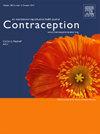产后立即插入左炔诺孕酮(LNG)节育器:插入技术和排出率分析
IF 2.3
2区 医学
Q1 OBSTETRICS & GYNECOLOGY
引用次数: 0
摘要
目的先前的研究报告显示,产后立即放置(IPP)宫内节育器的排出率高达 27%。目前尚不清楚可改变的插入技术是否会影响宫内节育器的排出率。我们研究了阴道分娩后插入 IPP LNG 宫内节育器的技术(手动 vs 器械涂抹器 vs 环形钳)是否与产后 6 个月的宫内节育器排出或其他并发症有关。方法我们对 2019-2022 年间在一家多医院医疗系统中经阴道分娩并接受 IPP LNG 宫内节育器 (Mirena®) 的所有患者进行了一项回顾性队列研究。我们通过 ICD-10 编码和 MAR 管理确定了符合条件的患者。我们手动提取了结果和混杂变量:排出、宫内节育器并发症、超声波的使用和产科特征。结果我们纳入了 647 例 IPP LNG 宫内节育器置入;48%(311 例)为人工置入,14%(90 例)通过环钳置入,38%(246 例)通过器械涂抹器置入。总体排出率为 14.4%。我们发现人工、环钳或器械涂抹器插入的宫内节育器排出率没有差异(分别为 14.8%、10.0% 和 15.4%;P=0.43),复合宫内节育器并发症的发生率也没有差异(分别为 13.2%、10.0% 和 16.7%;P=0.25)。与人工插入宫内节育器(11.3%;p <0.001)相比,医疗人员更倾向于使用带环钳的超声(24.4%)和器械涂抹器(22.0%)。我们的研究发现,宫内节育器排出率或并发症发生率与插入技术没有差异。这些发现应为产前长效可逆避孕法 (LARC) 咨询和产中实践模式提供参考。本文章由计算机程序翻译,如有差异,请以英文原文为准。
IMMEDIATE POSTPARTUM LEVONORGESTREL (LNG) IUD INSERTION: ANALYSIS OF INSERTION TECHNIQUE AND EXPULSION RATES
Objectives
Prior studies report expulsion rates for immediate postpartum (IPP) IUDs as high as 27%. It is unclear whether modifiable insertion techniques affect the expulsion rate. We examined whether the technique of IPP LNG IUD insertion after vaginal delivery (manual vs device applicator vs ring forceps) was associated with IUD expulsion or other complications by six months postpartum.
Methods
We conducted a retrospective cohort study of all patients who delivered vaginally and received an IPP LNG IUD (Mirena®) in a multihospital healthcare system from 2019-2022. We identified eligible patients using ICD-10 codes and MAR administration. We manually extracted outcomes and confounding variables: expulsion, IUD complications, use of ultrasound, and obstetrical characteristics. Statistical analysis was performed using chi square tests.
Results
We included 647 IPP LNG IUD insertions; 48% (311) were inserted manually, 14% (90) via ring forceps, and 38% (246) via device applicator. The overall expulsion rate was 14.4%. We found no difference in the rate of expulsion between manual, ring forceps, or device applicator insertion (14.8%, 10.0%, and 15.4% respectively; p=0.43), nor was there a difference in the rate of composite IUD complications (13.2%, 10.0%, and 16.7%, respectively; p=0.25). Providers were more likely to use ultrasound with ring forceps (24.4%) and device applicator (22.0%) compared to manual insertion (11.3%; p <0.001).
Conclusions
Real world data suggest an LNG IUD expulsion rate of 14% after vaginal delivery. Our study found no difference in rates of IUD expulsion or complication based on insertion technique. These findings should inform pre-delivery long-acting reversible contraception (LARC) counseling and intrapartum practice patterns.
求助全文
通过发布文献求助,成功后即可免费获取论文全文。
去求助
来源期刊

Contraception
医学-妇产科学
CiteScore
4.70
自引率
17.20%
发文量
211
审稿时长
69 days
期刊介绍:
Contraception has an open access mirror journal Contraception: X, sharing the same aims and scope, editorial team, submission system and rigorous peer review.
The journal Contraception wishes to advance reproductive health through the rapid publication of the best and most interesting new scholarship regarding contraception and related fields such as abortion. The journal welcomes manuscripts from investigators working in the laboratory, clinical and social sciences, as well as public health and health professions education.
 求助内容:
求助内容: 应助结果提醒方式:
应助结果提醒方式:


